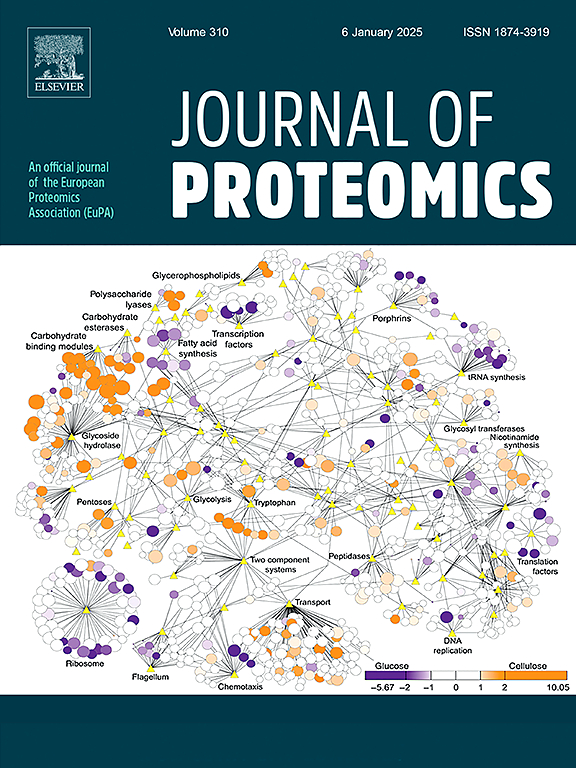Spatial and development responses in the wheat leaf highlight the loss of chloroplast protein homeostasis during salt stress
IF 2.8
2区 生物学
Q2 BIOCHEMICAL RESEARCH METHODS
引用次数: 0
Abstract
Salinity stress in wheat affects physiological and biochemical parameters in tissues that alter plant development and ultimately lower crop yield. Shoot tissues can accumulate high concentrations of sodium over time through the transpiration stream coming from the roots. This imposes physiological responses that align salt effects with the basipetal developmental gradient of the monocot leaf. The role of metabolic processes in generating and responding to these increases in sodium concentration over time was explored by linking changes in ion distributions to those of enzyme abundance from the base to the tip of leaves under salt stress. We found that enzymes for methionine synthesis and lipid degradation pathways increase, concomitantly with proteins in jasmonate synthesis, which are key players in plant stress-induced responses. Combining the use of Differential Abundance of Protein analysis and Weighted Correlation Network Analysis we have focused on identifying key protein hubs associated with responses to salt stress or salt susceptibility, shedding light on potential sites of salt sensitivity as targets for enhancing salt tolerance in wheat. We found chloroplast protein synthesis machinery, including the 30S and 50S ribosomal proteins, and plastid localised protein synthesis elongation factors, were significantly reduced in abundance and correlated with the altered K+/Na+ ratio along salt-stressed wheat leaves. Additionally, the plastid protease system including ATP-dependent caseinolytic protease and filamentous temperature-sensitive H proteases involved in chloroplast protein homeostasis, show decreased abundance with salt. The complex interplay of these processes in and across the leaf affects overall plant viability under salt stress mainly affecting the energy homeostasis in wheat shoot.
Data are available via ProteomeXchange with identifier PXD059765.
Significance
Soil salinity is a major agricultural challenge that cause significant reduction in wheat yields, a staple crop vital for global food security. Despite extensive breeding efforts, developing salt-tolerant wheat remains challenging due to the complex, multi-genic nature of salinity tolerance. While numerous studies have explored molecular responses to salt stress making salt to control comparisons, there is little consensus on the primary points of metabolic disruptions that would determine the salt response in wheat. Our study addresses this gap by integrating proteomics with Weighted Correlation Network Analysis to examine metabolic responses along the developmental gradient of wheat leaves. By exploiting the natural base-to-tip progression of leaf maturation under salt stress, we identify key protein groups linked to salt response. These findings provide new insights into potential metabolic targets for enhancing wheat's resilience to salinity stress.

小麦叶片的空间和发育响应强调了盐胁迫下叶绿体蛋白稳态的丧失。
盐胁迫影响小麦组织的生理生化参数,从而改变植株发育,最终降低作物产量。随着时间的推移,茎部组织可以通过来自根部的蒸腾流积累高浓度的钠。这就施加了生理反应,使盐的作用与单子叶的基基发育梯度一致。通过将盐胁迫下从根部到叶尖的离子分布变化与酶丰度的变化联系起来,研究了代谢过程在钠浓度随时间增加而产生和响应中的作用。我们发现,与茉莉酸合成蛋白相关的蛋氨酸合成和脂质降解途径的酶增加,而茉莉酸合成是植物胁迫诱导反应的关键参与者。结合蛋白差异丰度分析和加权相关网络分析,我们重点确定了与盐胁迫或盐敏感性反应相关的关键蛋白枢纽,揭示了盐敏感性的潜在位点作为提高小麦耐盐性的靶点。我们发现,在盐胁迫下,小麦叶片叶绿体蛋白合成机制(包括30S和50S核糖体蛋白)和质体局部蛋白合成延伸因子的丰度显著降低,并与K+/Na+比值的改变相关。此外,质体蛋白酶系统,包括atp依赖性酪蛋白溶解蛋白酶和丝状温度敏感的H蛋白酶参与叶绿体蛋白稳态,显示丰度随盐降低。盐胁迫下,这些过程在叶片内和叶片间的复杂相互作用影响植物的整体生存力,主要影响小麦茎部的能量稳态。数据可通过ProteomeXchange获得,标识符为PXD059765。意义:土壤盐碱化是一项重大的农业挑战,导致小麦产量大幅下降,而小麦是全球粮食安全的重要作物。尽管进行了大量的育种工作,但由于耐盐性的复杂性和多基因性,开发耐盐小麦仍然具有挑战性。虽然许多研究已经探索了盐胁迫下的分子反应,并将盐作为对照,但在决定小麦盐反应的代谢中断的主要方面,人们几乎没有达成共识。我们的研究通过结合蛋白质组学和加权共表达网络分析(WCNA)来研究小麦叶片沿发育梯度的代谢反应,从而解决了这一空白。通过利用盐胁迫下叶片成熟的自然从碱基到尖端的过程,我们确定了与盐反应相关的关键蛋白群。这些发现为提高小麦抗盐胁迫能力的潜在代谢靶点提供了新的见解。
本文章由计算机程序翻译,如有差异,请以英文原文为准。
求助全文
约1分钟内获得全文
求助全文
来源期刊

Journal of proteomics
生物-生化研究方法
CiteScore
7.10
自引率
3.00%
发文量
227
审稿时长
73 days
期刊介绍:
Journal of Proteomics is aimed at protein scientists and analytical chemists in the field of proteomics, biomarker discovery, protein analytics, plant proteomics, microbial and animal proteomics, human studies, tissue imaging by mass spectrometry, non-conventional and non-model organism proteomics, and protein bioinformatics. The journal welcomes papers in new and upcoming areas such as metabolomics, genomics, systems biology, toxicogenomics, pharmacoproteomics.
Journal of Proteomics unifies both fundamental scientists and clinicians, and includes translational research. Suggestions for reviews, webinars and thematic issues are welcome.
 求助内容:
求助内容: 应助结果提醒方式:
应助结果提醒方式:


